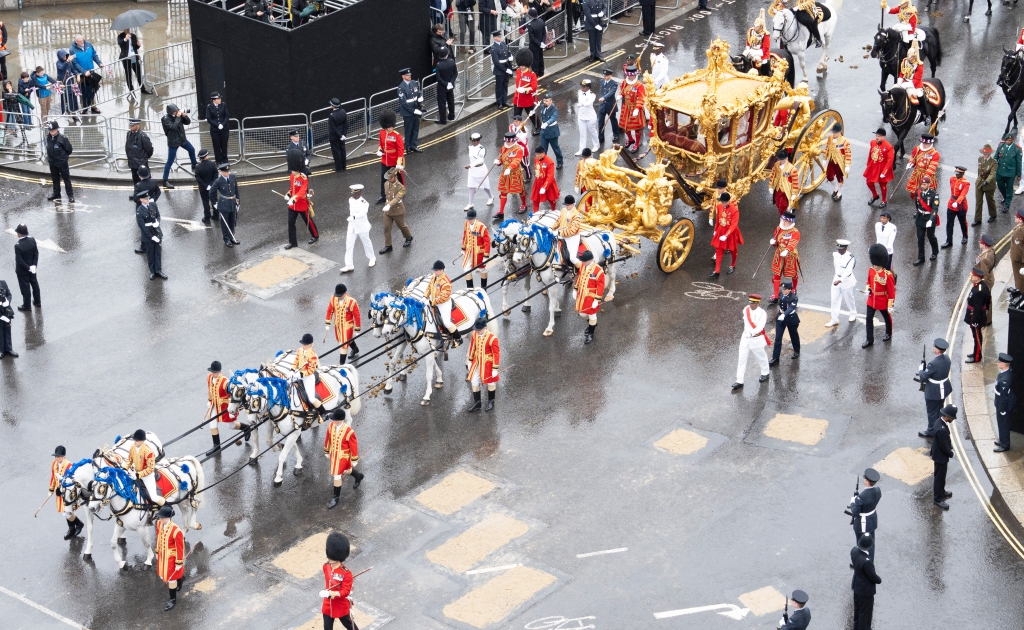
By Department for Culture, Media and Sport – Gold State Coach, drawn by 8 Windsor Grey horses, PDM-owner, https://commons.wikimedia.org/w/index.php?curid=131603435
Over the last year or so, there have been three major royal occasions in the history of the United Kingdom. In June 2022, joyous celebrations marked the Platinum Jubilee of the late Queen Elizabeth II. Crowds gathered in fevered excitement in London to catch a glimpse of the Royal Family and there were street parties around the country. This was then followed by a period of national mourning that culminated in the Queen’s State Funeral in September 2022. On a happier note, the Coronation of King Charles III took place in May this year. Members of the public lined the streets to watch the triumphal procession of the State coaches and at home on television, millions were glued to their televisions to observe the sacred ceremony at Westminster Abbey. All these events were marked with pageantry, spectacle and of course, horses!
The Royal family and in particular, the late Queen Elizabeth, have always had a great love of horses and they play a tremendous role on these important ceremonial occasions. Immaculately turned out, they pull the elaborate coaches and form the accompanying procession. Also on display are the loyal household servants who take care of the horses every day. In this article, I will be sharing the story of one of these servants, a coachman, Joseph Osborn, who served the Royal Family faithfully for nearly forty years.
In the summer of 1841, Joseph Osborn was born in the parish of Paulerspury, just outside of Towcester, Northamptonshire. Sadly, his father, Joseph senior, an agricultural labourer, died when he was just two years old at the age of 42. In the 1851 census, his widowed mother, Mary Ann, who was described as a pauper, was living in a cottage in Paulerspury at Pury End, with Joseph and his two older brothers, Thomas and George. The family’s situation was no doubt precarious with the loss of their main breadwinner. It was fortunate that Mary Ann had managed to keep the family together and out of the workhouse. Soon the boys would be off to make their own way in the world. However, whilst Thomas and George found jobs as agricultural labourers in the local area, Joseph took a different path. Initially, he may have found a job as a groom, working on an estate for one of the big houses in the area. What is known for certain is that he moved to the London area as a young man. His sweetheart from back home, Mary Ann Craddock, came with him and the two teenagers married on May 28th 1860 at Christ Church, Forest Hill, Kent.

Joseph and Mary Ann both gave their residence as 2 South Road in the marriage register. Christ Church, where they were wed, was a brand new church, as it was only consecrated in 1855 and had yet to be completed. It was funded by the Earl of Dartmouth, as the centrepiece of his new estate. The new church was situated at the junction of Church Rise and South Road. It is probable that Joseph had found a job as a groom at Tudor Hall on South Road, then known as Red Hall. Built in 1854/55 it is believed to have been occupied around this time by one of Queen Victoria’s maids of honour. This might explain how he later came to be working for the Royal Household. Further information and a photograph of the house can be found here: https://www.ideal-homes.org.uk/lewisham/assets/galleries/forest-hill/tudor-hall.html
Shortly after they were married, Joseph and Mary Ann moved to Sunninghill, Berkshire, where they are recorded in the 1861 census with their three month old daughter, Martha, living at Bowldish Farm. Joseph was still working as a groom, perhaps at Sunninghill Park, a country house and estate adjoining Windsor Great Park. One imagines that since he worked with horses, he would have taken a keen interest in the racing at Royal Ascot, the racecourse being very close to his home.
Given his proximity to Windsor and potential Royal connections, it is perhaps not surprising that Joseph Osborn then found a job working for the Royal Family. He started out working as a groom for Bertie, the Prince of Wales, later King Edward VII, and his wife, Queen Alexandra, at the stables of Marlborough House. Built by Sir Christopher Wren in 1711 for Sarah, the Duchess of Marlborough, Marlborough House is situated on the Mall in St James, Westminster.
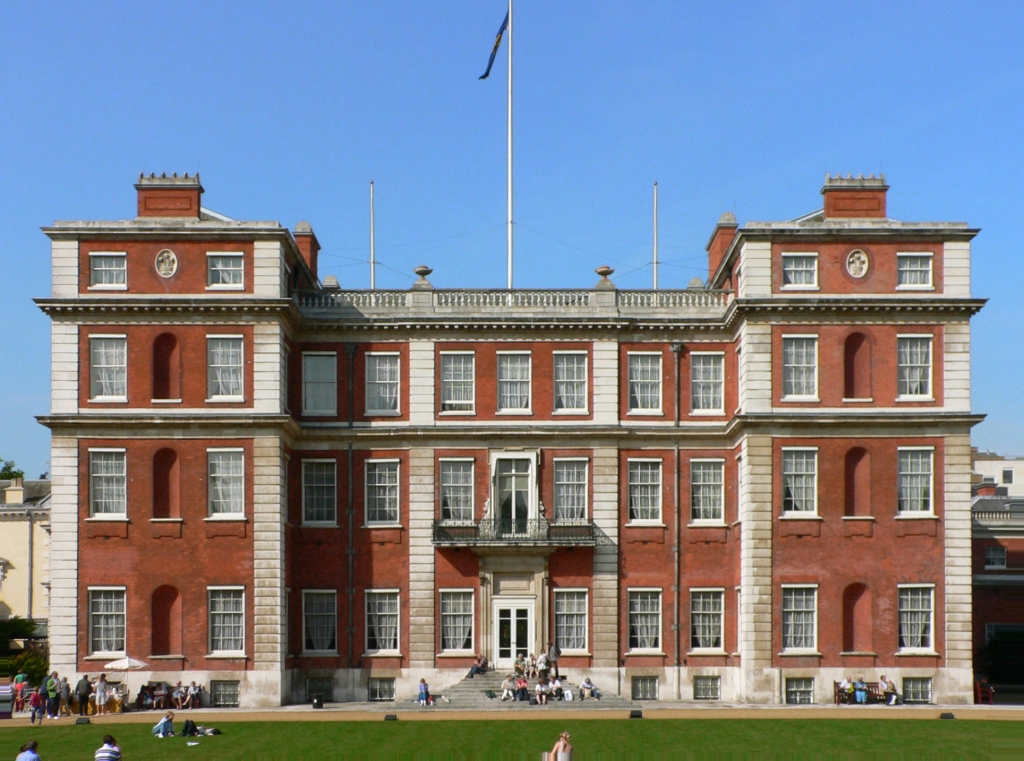
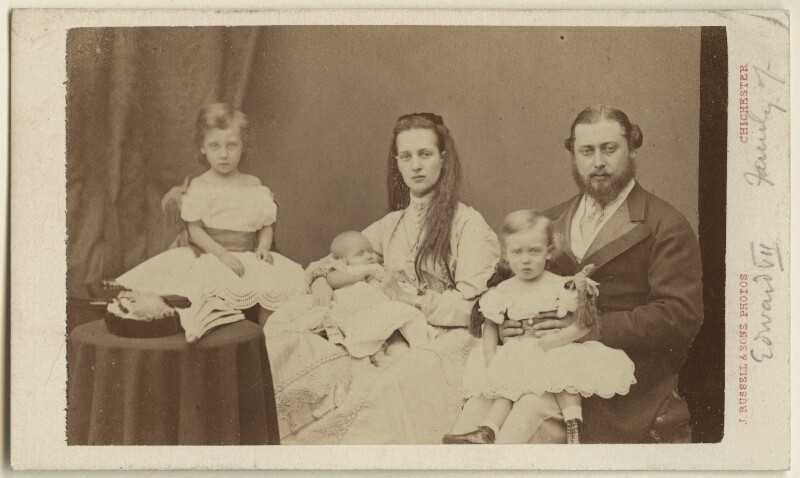
by James Russell & Sons
albumen carte-de-visite, July 1867
NPG Ax24163
© National Portrait Gallery, London
Bertie and his wife, Princess Alexandra, had married on March 10 1863 at St George’s Chapel, Windsor and immediately set up their town residence at Marlborough House, which had been gifted to Bertie in 1850. Alterations were made to Marlborough House to make it a suitable residence for the Prince and his new bride. This included work on the existing stables, to the north-east of the house, which were substantially enlarged. Parliament had granted £5000 for the project.
…the Marlborough House stables are on two tiers, connected by an easy gradient, and in their altered form had a dozen loose boxes and thirty-five stalls: the coach houses are roomy and complete, the apartments for the upper servants and stablemen are all that can be desired, while there are bath rooms for all.
The Field, The Country Gentleman’s Newspaper 21 June 1902 https://www.britishnewspaperarchive.co.uk
Joseph Osborn was certainly working for the Prince of Wales by late 1864. His eldest son, George Harry, born in the November of that year at Marlborough House, was baptised back in Northamptonshire, in Abingdon, his mother’s home parish, in 1865. The record of baptism states that his father was as an outrider, a mounted attendant, who would have gone either before or after a carriage, at Marlborough House:

via https://www.ancestry.co.uk
Northamptonshire Record Office; Northampton, England; Register Type: Bishops Transcripts
At Marlborough House, Bertie and Alexandra entertained the cream of London society, who were known as “The Marlborough House Set”, with balls and parties. After the death of his father, Prince Albert, Bertie had taken on many of the social responsibilities of his mother, who was in a long period of mourning. Apart from the aristocracy, members of the set included horse racing enthusiasts, bankers, politicians, lawyers, actresses and American heiresses. Popular with the general public, the set invited the approbation of Queen Victoria and others who condemned them for their loose morals and adulterous behaviour. The servants no doubt saw many things that raised eyebrows but absolute discretion was imperative.
At the time of the 1871 census, Joseph, was listed amongst the servants as a groom at the stables of Marlborough House. He is, in fact, recorded as “George Ashbourne”. The second coachman was George Ashbourn, so this was probably the reason for the mix-up. Altogether, thirty three men were employed to look after the horses. These included coachmen, grooms, postillions, (who would ride the horses), livery and stable helpers. Fortunately, quarters were provided for those who had wives and children.
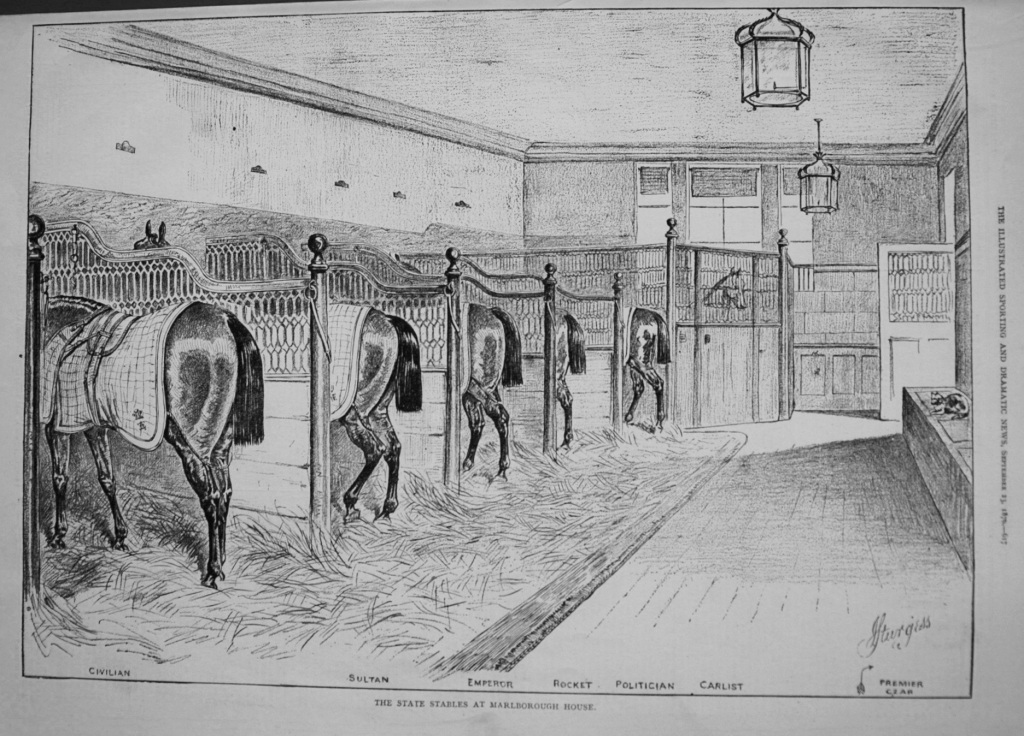
Joseph Osborn and his family were to live at Marlborough House for many years. At the time of the 1881 census, Joseph had been promoted to fourth coachman:

A defining moment in Joseph’s career happened a few months later. One afternoon on Monday July 11th 1881, the daughters of the Prince and Princess of Wales, Princesses Louise Victoria, Victoria Alexandra and Maud, went out for a drive in Hyde Park with their governess. Suddenly, the pair of horses bolted and the carriage went out of control. It collided with a lamp post, shattering a wheel, just short of Marlborough House but thanks to the quick thinking and composure of the coachman, the party were able to alight safely unhurt. The dramatic incident was reported in many newspapers at the time:
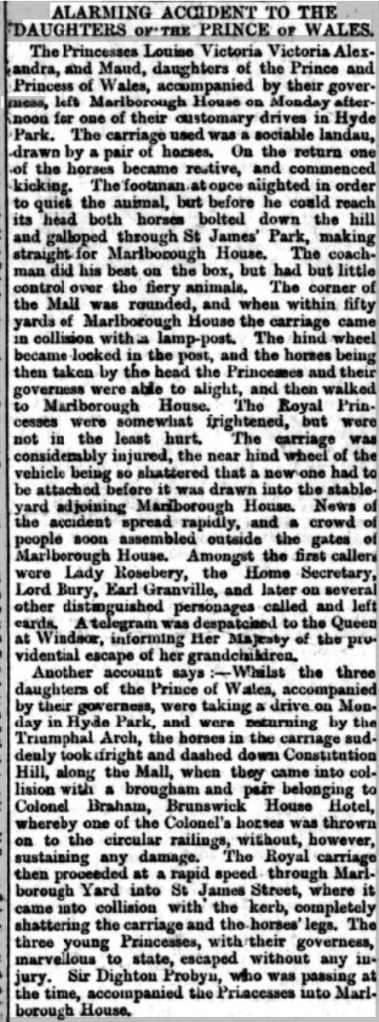
Although unnamed in the newspapers, it was remarked that the “coachman did his best on the box, but had little control over the fiery animals”. The coachman was Joseph Osborn. A letter about the incident was written by Sir Henry Ponsonby, Queen Victoria’s Private Secretary, on August 18th 1881 and sent to Sir Dighton Probyn, a Royal courtier, holder of the Victoria Cross, and an equerry to the Prince of Wales:
My dear Probyn, The Queen has heard from many quarters great praise of the conduct of the Coachman who drove the Princesses when the accident occurred last month and has commanded me to ask you to give him this Pin as a present from Her Majesty in recognition of his coolness and steadiness on that occasion when he saved the Queen’s granddaughters from what might have been a serious accident. yours very truly Henry A Ponsonby
The original letter and the pin were given to Joseph Osborn by the order of the Prince of Wales on August 23 1881. A photograph of the pin is below:
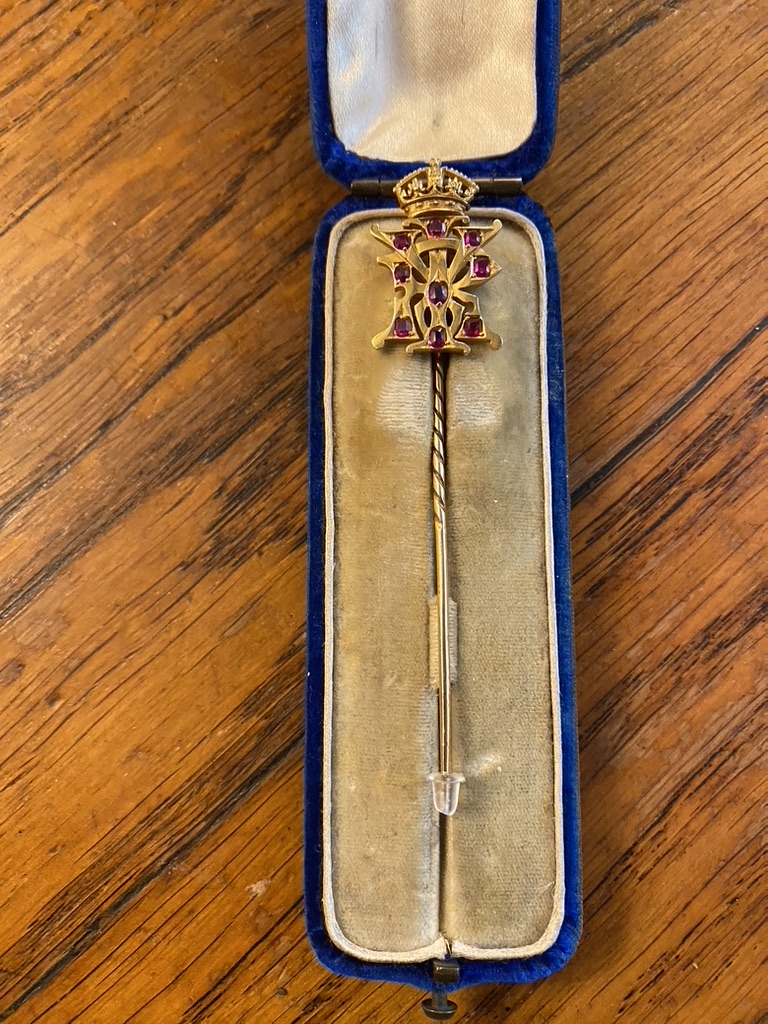
When Joseph Osborn was presented with the pin, it must have been one of the proudest moments in his life. Later on 7 September, Probyn wrote again to Sir Henry Ponsonby, telling him about the presentation:
I waited till I met Kingscote in London, which I did the other day, before giving the Pin to Osborne the Coachman. We then assembled the Coachmen together, and in the presence of all, gave the Queen’s handsome present to Osborne. The good little fellow really cried with gratitude and delight. I promised him to beg of you to thank Her Majesty for this handsome present.
I have given him your letter to me, to keep.
Letter from Probyn to Sir Henry Ponsonby 7th September 1881
Royal Archives RA VIC/Z 454/156
The carriage driven by Joseph Osborn on that day would have been similar to the one below:
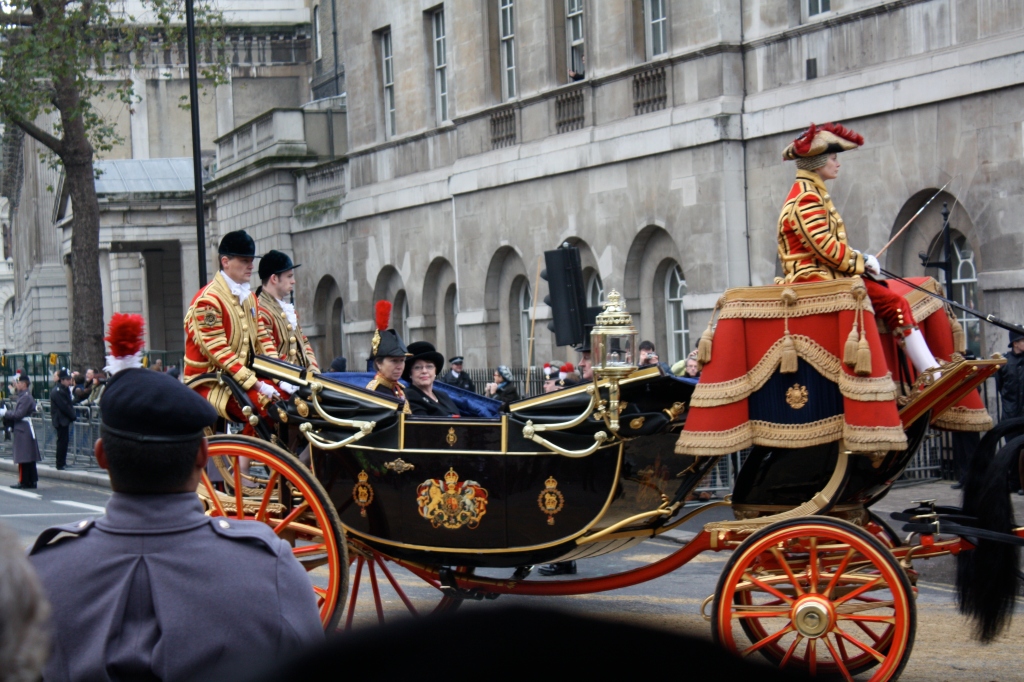
By robertsharp – State Opening of Parliament 2008 VIUploaded by motopark, CC BY 2.0, https://commons.wikimedia.org/w/index.php?curid=15105784
Some years ago, the Royal Archives were contacted to see what information they might have on Joseph Osborn. They have in their possession, a remarkable letter, written by Sir Dighton Probyn and sent to Queen Victoria that describes the incident in detail:
… The 3 little princesses went out driving in the afternoon, in their open landau, as usual. They had been round the Park, and as they were crossing over Piccadilly, at Hyde Park Corner, first before entering St James’s Park, one of the Horses got restive. The carriage had entered St James’s Park, when, from restiveness, the Horse set to kicking. The Footman by the desire of the Coachman (Osborne by name, a most excellent little fellow and a good driver) jumped down to get at the Horse’s head – but he was too late. The Horse kicked over the pole, then sat back again, and then bolted. Away they went, down Constitution Hill, into the Mall, at a racing pace. Osborne remained perfectly cool. He told Mad. Vauthier (who was with the children), to sit still. He put his whip into the “Whip Socket”, took a short hold of the reins, and pulled his utmost – but, Horses are stronger than Men! An Officer who saw it all, told Sir Dighton that no man could have driven better than Osborne did under the circumstances. Osborne’s intention was to have made for the Horse Guards Parade, and to have taken the Horses round and round that place till they stopped, but some idiot of a Coachman crossed him with a carriage, and to save a collision, Osborne was forced to turn up sharp to the left along the road between Marlborough House and St James’s Palace. This was the best thing for him to do. He was defeated in his object of getting to the Horse Guards Parade, and then determining to try St James’s Street, hoping that he might perhaps tire them up that Hill. He was getting a little pull over his Horses at this time, steered them safely through the Park Gates between Marlborough House and the Palace, then took them to the left, to go outside the big Lamp post. In rounding this Lamp post to go up St James’s Street, the carriage was almost swung over – it slided with tremendous force against the Kerb Stone near the “Thatched House Club” at the bottom of St James’s Street. It went with such force against the Kerb Stone here, that the near (left) hind wheel was smashed to pieces. This of course brought the carriage down on that side, as the wheel was off. The carriage being then on the ground, or at any rate only on 3 wheels, the Horses, with Osborne still pulling manfully against them, could not take it much further. Their pace too was instantly decreased and some men in the street rushed at their Heads. In fact after the Collision against the Kerb Stone, the Horses did not take the carriage 20 yards. It pulled up opposite “Arthur’s Club”. The children were immediately taken out of the broken carriage, and taken into the Club ….
Letter from Sir Dighton Probyn to Queen Victoria in 1881
Royal Archives RA VIC/Z 454/156
In 1899, Joseph Osborn appeared in the newspapers as a witness to a fatal accident. Travelling in a cab between Queen Victoria Street and the Embankment, he witnessed a man who crossed the road without looking, which resulted in him being knocked over and killed:
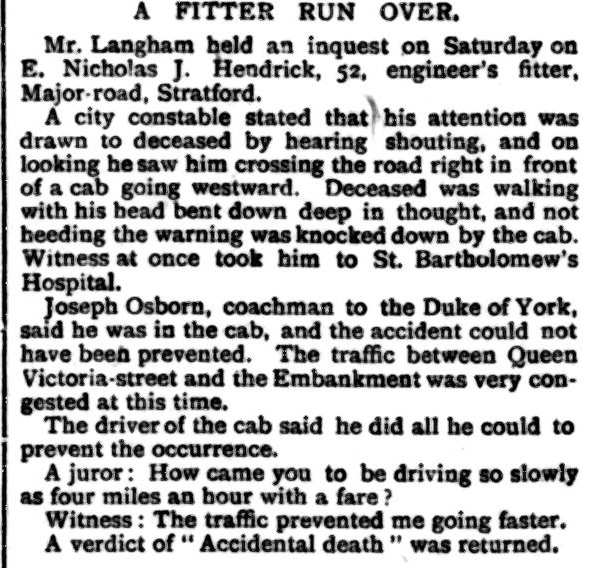
This article states that Joseph Osborn was a coachman for the Duke of York, the future George V, who was born at Marlborough House in 1865. His coachman would have known him from birth.
Later that year, in 1899, Mary Ann, the wife of Joseph died. This resulted in Joseph, by now aged 58, boarding with his long-term colleague and friend, William Blyth, at the Royal stables in the 1901 census. The following year, on January 2 1902, Joseph married again. His new wife, Elizabeth Avery, was a 50 year old spinster and with Bertie now King after the death of his mother, Queen Victoria, Joseph retired to Battersea with his new wife with the satisfaction of a job well done. He was also in receipt of a pension for his long years of service, which was paid until his death on 4 June 1920 when the balance was paid to his widow. In recognition of his service, he was also awarded three additional pins, gifted by Queen Victoria. They are items of beauty and craftsmanship:
Searching newspapers, I couldn’t find an account of the retirement of Joseph Osborn, but I did find one for his friend, William Blyth, that illustrates the standing of the coachmen with the Royal family. William had retired at the age of 71 and was interviewed by the Press at Buckingham Palace:

This interview shows what an intimate relationship the coachmen had with the Royal family. Many had known the Royal princes and princesses from babyhood and watched them grow up. They also were present at all the State occasions along with their beloved horses. Blyth particularly remembered the joyous occasions of the marriages of the Prince of Wales, the Duke of Connaught, the Duchess of Fife and the Queen of Norway, events that Joseph Osborn would also have attended.
Joseph Osborn also handed over the baton of service to his son, Joseph Osborn junior. Joseph junior was born at Marlborough House on 5 May 1872. According to research in the Royal Archives, he entered service on 17 September 1885, probably starting as a groom at the stables for the Prince of Wales, just like his father before him. In 1893, he joined the new Household of the Prince’s son, the Duke of York, as 3rd Coachman. The Duke of York had been born at Marlborough House in 1865, and was later Prince of Wales and, from 1910, King George V.
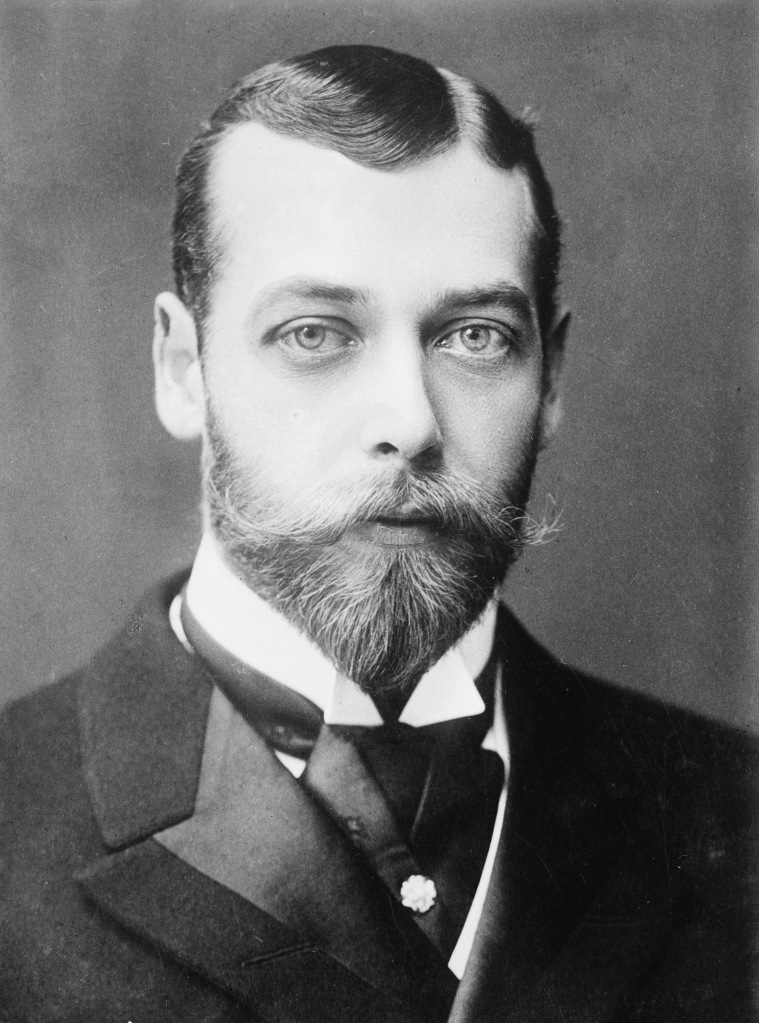
By Bain News Service, publisher – This image is available from the United States Library of Congress’s Prints and Photographs divisionunder the digital ID ggbain.05537.This tag does not indicate the copyright status of the attached work. A normal copyright tag is still required. See Commons:Licensing., Public Domain, https://commons.wikimedia.org/w/index.php?curid=2649296
Joseph Osborn junior remained in the service of the Duke of York (later King) as a coachman until he retired with a pension on 1 November 1922. However, he continued to live in the Royal Mews at Windsor until his death. He did occasional ceremonial work as an Under State Porter until he resigned in 1949 due to ill-health. After his death in 1950, his widow was given a compassionate allowance by the King and allowed to live on in the house in the Royal Mews until her death in 1953.
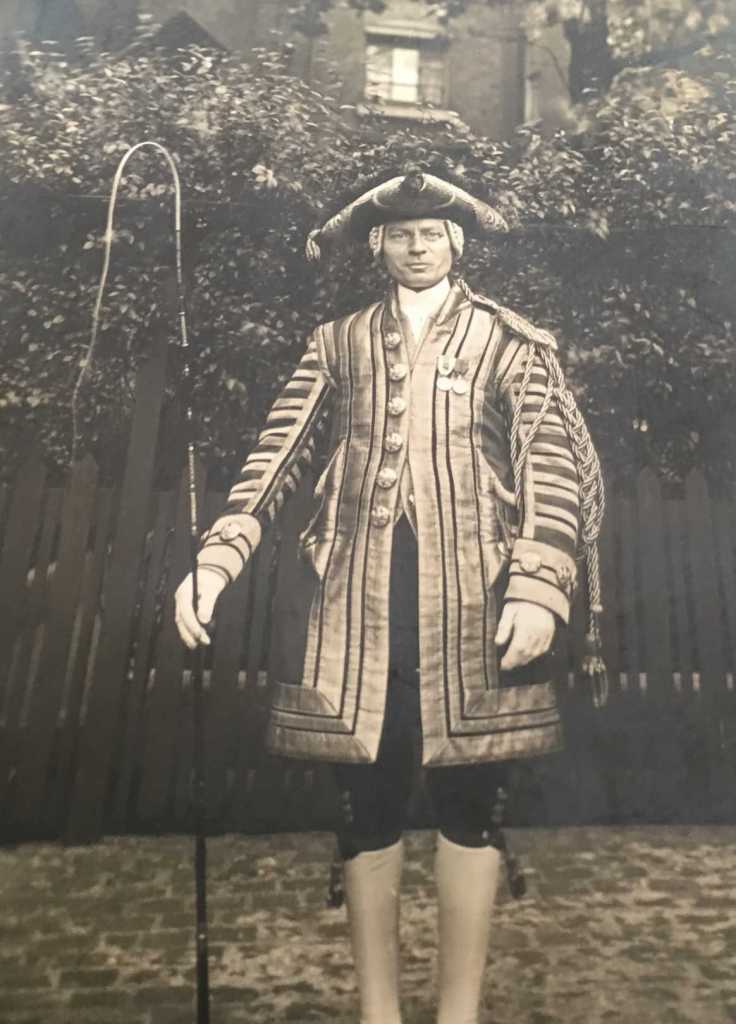
@Family of Joseph Osborn
Joseph Osborn junior received a large number of medals in recognition of his long and faithful, service:
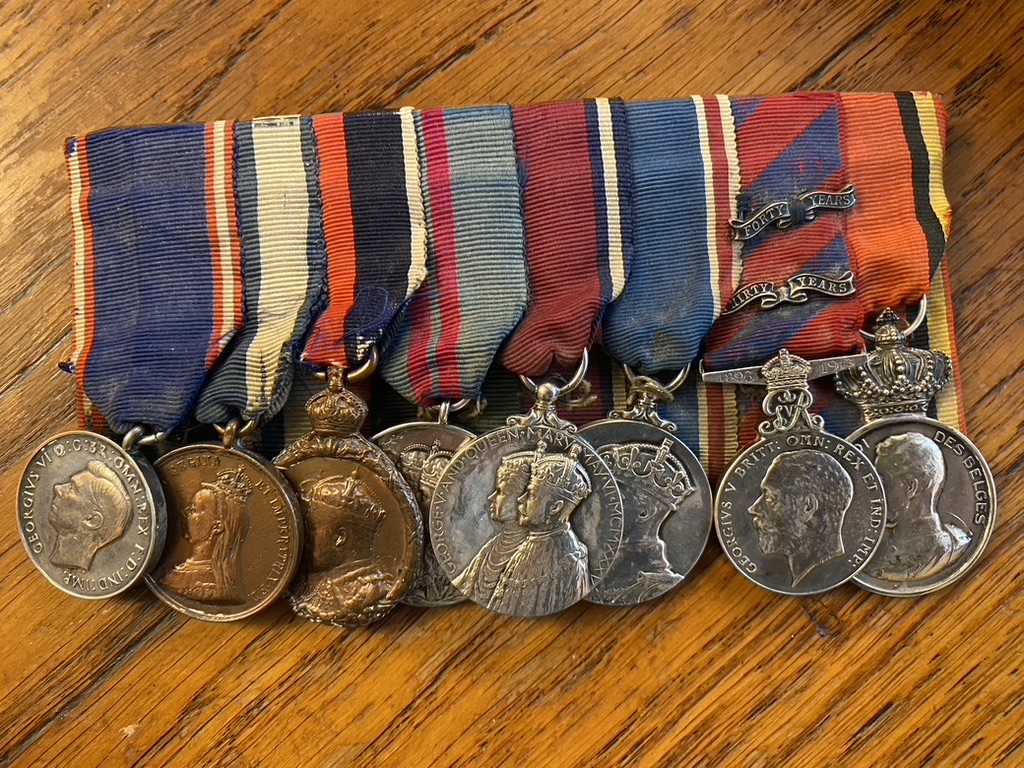
Royal Victorian Medal GVIR
Jubilee 1897, bronze
Coronation 1902, bronze
Coronation 1911, silver
Jubilee 1935, silver,
Coronation 1937, silver
Royal Household Faithful Service Medal GVR clasps 30 Years & 40 Years
Belgian Royal Household Medal Albert I, silver (awarded for servants in Foreign Courts) @Family of Joseph Osborn
The story of Joseph Osborn senior and as a Royal coachman is a remarkable one. Orphaned when he was only two years old, he left a life of poverty as an agricultural labourer in Northamptonshire and came to London in his teens. Finding work as a groom, he must have had a love of horses from an early age. After coming to the attention of the Royal Family, he worked his way up and became a coachman, living and working at the Royal Mews at Marlborough House for nearly forty years, becoming intimately acquainted with the family of Bertie, the Duke of York, who would later be King Edward VII. The accident with the coach in 1881 involving Queen Victoria’s grandchildren was obviously of huge significance. His quick thinking and cool composure saved them from injury or worse and he was personally recognised by Queen Victoria herself. It is interesting to have the detailed account of his actions, described in a letter preserved in the Royal Archives. No doubt he was very proud that his son also followed in his footsteps in his equally long service to the Duke of York, later, King George V.
@Judith Batchelor 2023
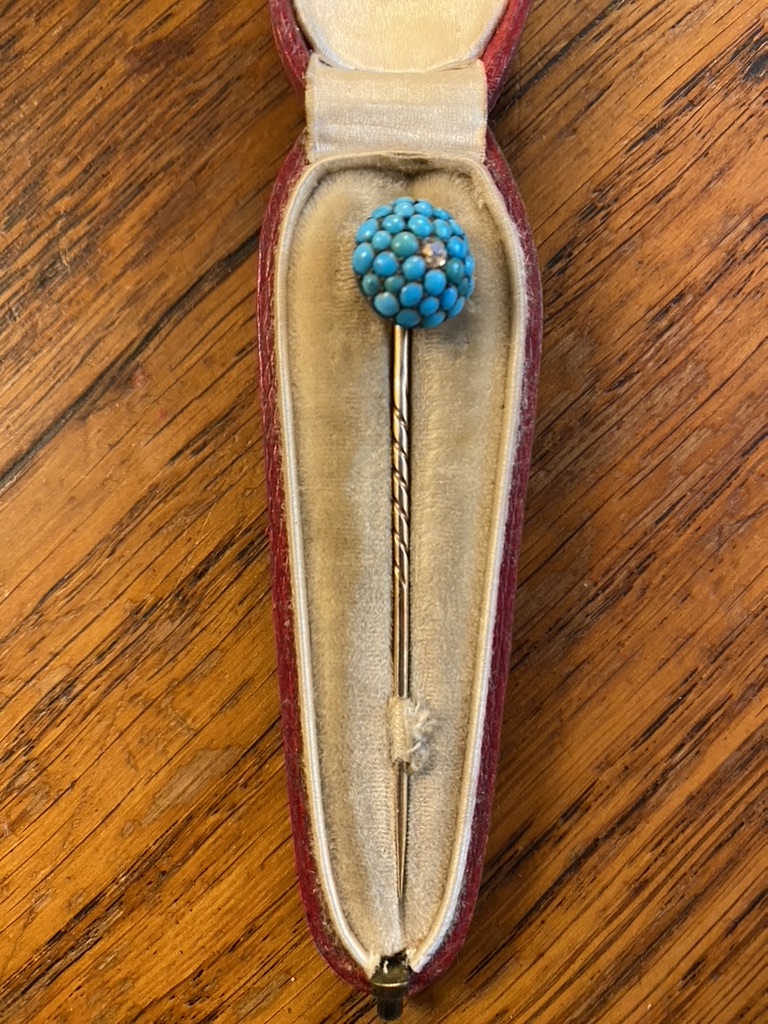
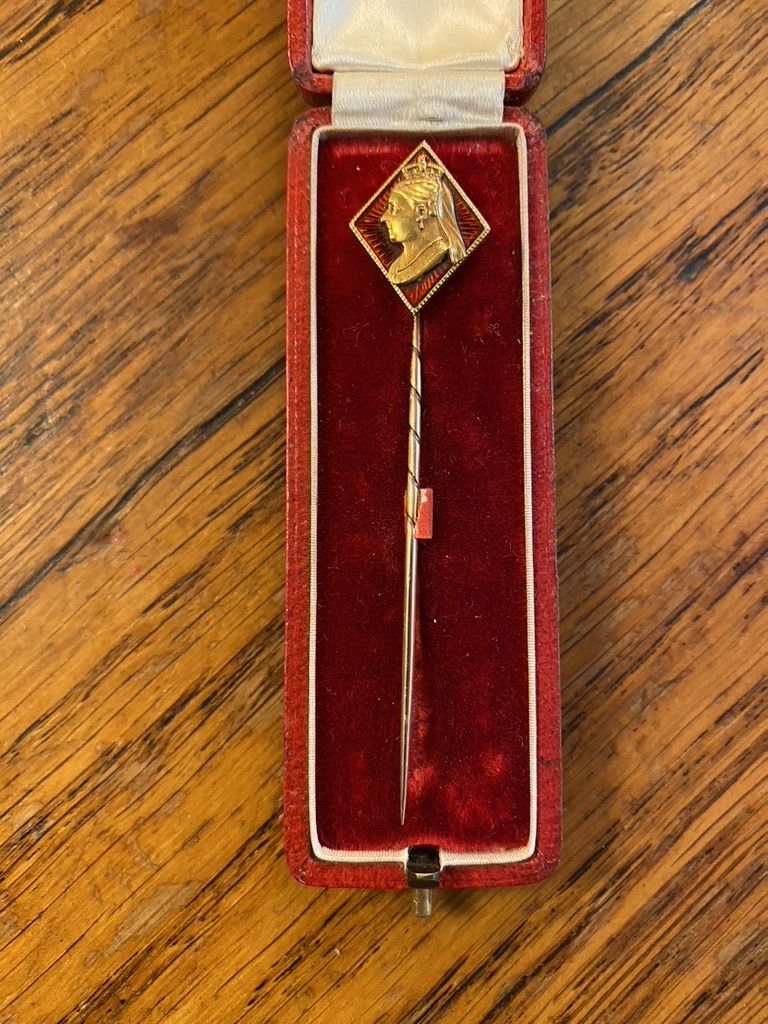

Great article!
LikeLiked by 1 person
Thank you!
LikeLike
Judith, just read the attached article!
LikeLiked by 1 person
It’s wonderful that he was able to go from being an orphan in a labouring family to achieve such a position. And to have those pins, and the account of his bravery, is really special. Is this your relative, Jude, or the relative of a client?
LikeLiked by 1 person
Although he is not my ancestor, he is related to my sister in law’s family. When my sister in law showed me the medals, pins and letter sent on Queen Victoria’s behalf, I had to share the story. I thought he had fascinating life.
LikeLike
That’s quite the family story! A shame Joseph wasn’t named in the newspaper article about being the coachman who saved the princesses.
Have to admit, though, that the upper classes referring to Joseph as “a little fellow” does grate on my nerves. Such attitudes are so baffling to me, but I guess in the past, those on the lower strata were used to it.
LikeLike
That comment about him being “a little fellow” does stick out like a sore thumb to modern ears! It sounds so condescending, but as you say, perhaps it was not so unusual at the time! Perhaps he was also short in stature.
It does make you think that one’s ancestors might well appear many times in newspapers but if they were not prominent, they were nameless so we remain none the wiser.
LikeLike